Woodhouse Lane leads to Headingley, home of Leeds Rhinos (rugby league) and Yorkshire Carnegie (rugby union) teams, along with Yorkshire County Cricket Club. It was at Headingley, in 1932, that the Leeds-born spinner Hedley Verity took 10 wickets for 10 runs – still the best bowling analysis in first-class cricket. Verity played in 40 test matches, taking 100 wickets in a shorter time than any other English bowler. He died in 1943 from his wounds, in a prisoner of war camp in Italy.
A framed photograph and text about Hedley Verity.
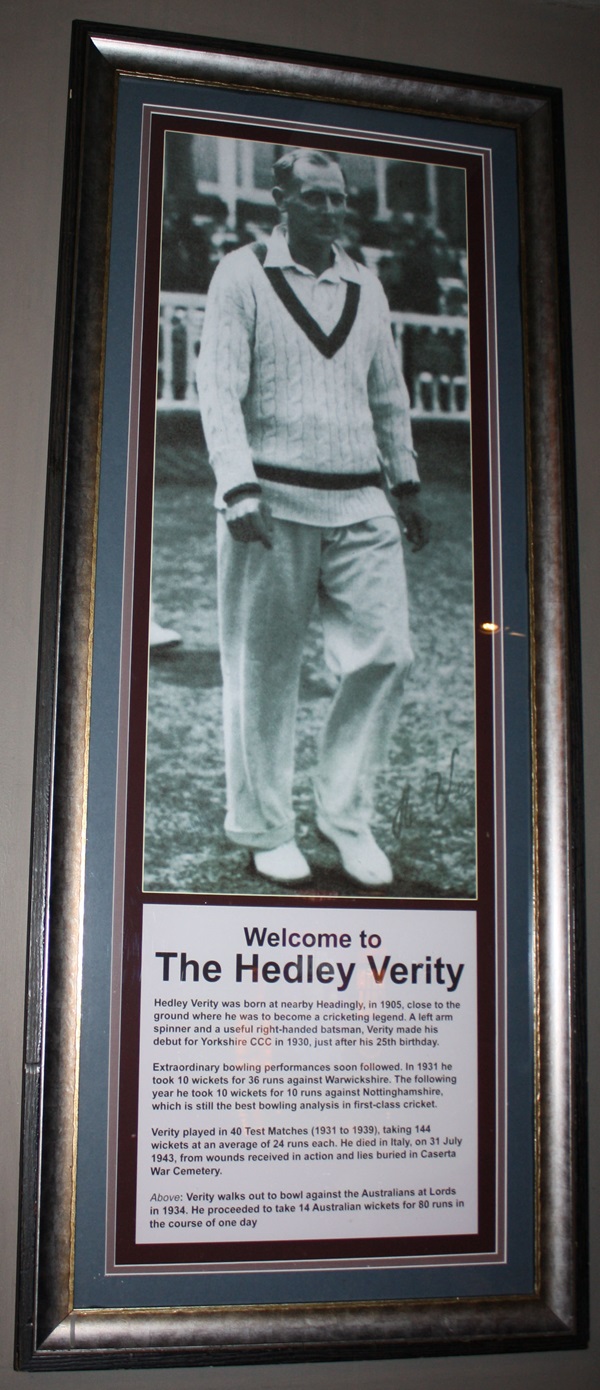
The text reads: Hedley Verity was born at a nearby Headingly, in 1905, close to the ground where he was to become a cricketing legend. A left arm spinner and a useful right-handed batsman, Verity made his debut for Yorkshire CCC in 1930, just after his 25th birthday.
Extraordinary bowling performances soon followed. In 1931 he took 10 wickets for 36 runs against Warwickshire. The following year he took 10 wickets for 10 runs against Nottinghamshire, which is still best bowling analysis in first-class cricket.
Verity played in 40 Test Matches (1931 to 1939), taking 144 wickets at an average of 24 runs each. He died in Italy, on 31 July 1943, from wounds received in action and lies buried in Caserta War Cemetery.
Above: Verity walks out to bowl against Australians at Lords in 1953. He proceeded to take 14 Australian wickets for 80 runs in the course of one day.
A framed photograph of Hedley Verity.
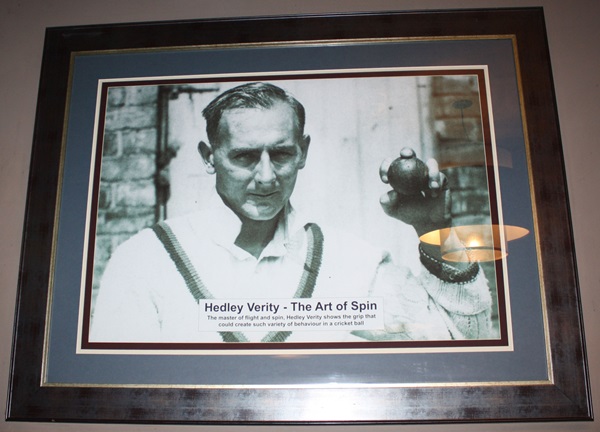
The text reads: The master of flight and spin, Hedley Verity shows the grip that could create such variety of behaviour in a cricket ball.
A framed photograph and text about Headingley Cricket Ground.
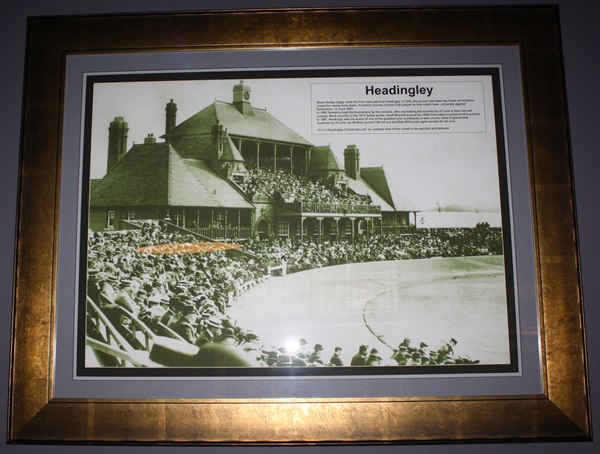
The text reads: Ehen Hedley Verity made his first class debut at Headingly, in 1930, the ground had been in the home of Yorkshire cricket for nearly forty years. Yorkshire County Cricket Club played its first match here – a friendly against Derbyshire – in June 1891.
In 1902 Yorkshire beat the Australians by five wickets, after dismissing the tourists for 23 runs in their second innings. More recently, in the 1977 Ashes series, Geoff Boycott scored his 100th first-class hundred on this ground. In 1891, Headingly was the scene of one of the greatest-ever comebacks in test cricket, when England beat Australia by 18 runs. Ian Botham scored 149 not out and Bob Willis took eight wickets for 43 runs.
Picture: Headingley Cricket Ground; an undated view of the crowd in the Pavilion and terraces.
Framed photographs and text about Barbara Hepworth.
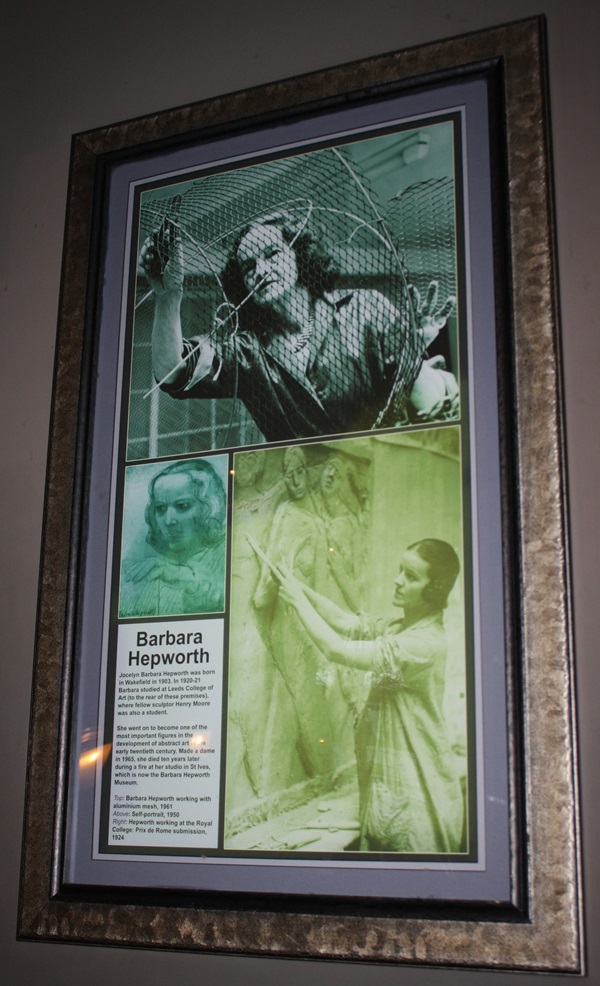
The text reads: Jocelyn Barbara Hepworth was born in Wakefield in 1903. In 1920-21 Barbara studied at Leeds College of Art (to the rear of these premises), where fellow sculptor Henry Moore was also a student.
She went on to become one of the most important figures in the development of abstract art in the early twentieth century. Made a dame in 1965, she died ten years later during a fire at her studio in St Ives, which is now the Barbara Hepworth Museum.
Top: Barbara Hepworth working with aluminium mesh, 1961
Above: Self-portrait, 1950
Right: Hepworth working at the Royal College: Prix de Rome submission, 1924.
A framed photograph and text about of John Atkinson Grimshaw.
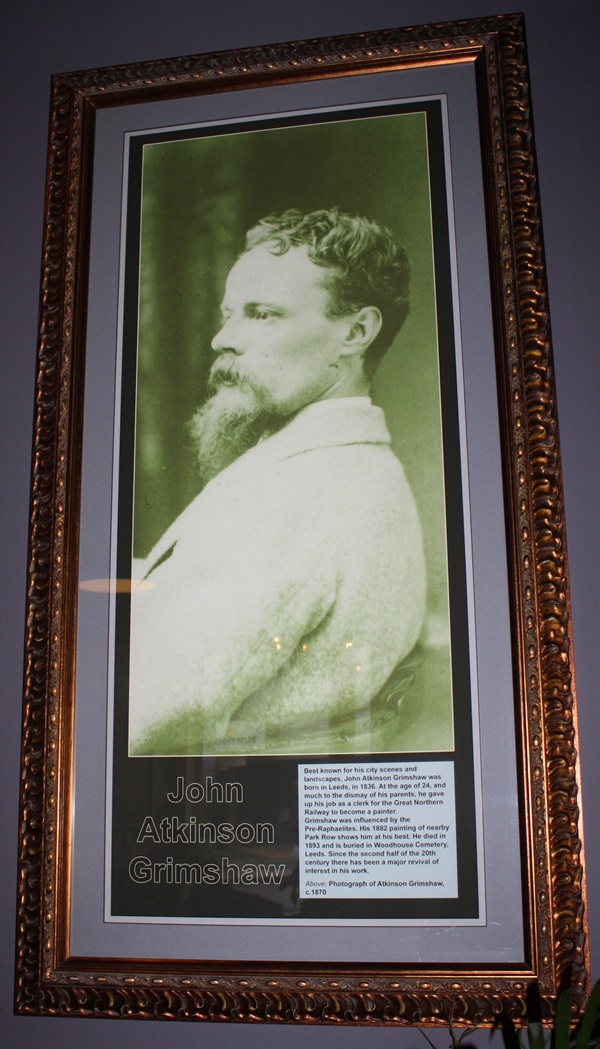
The text reads: Best known for his city scenes and landscapes, John Atkinson Grimshaw was born in Leeds, in 1836. At the age of 24, and much to the dismay of his parents, he gave up his job as a clerk for the Great Northern Railway to become a painter.
Grimshaw was influenced by the Pre-Raphaelites. His 1882 painting of nearby Park Shows him at his best. He died in 1893 and is buried in Woodhouse Cemetery, Leeds. Since the second half of 20th century there has been a major revival of interest in his work.
Above: John Atkinson Grimshaw, c.1870.
Framed photographs, drawing and text about Joseph Priestley.
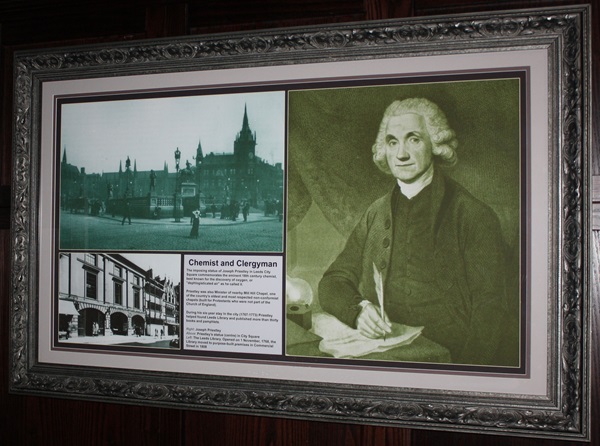
The text reads: The imposing statue of Joseph Priestley in Leeds City Square commemorates the eminent 18th century chemist, best known for the discovery of oxygen, or “dephlogisticated air” as he called it.
Priestley was also a Minister nearby Mill Hill Chapel, one of the country’s oldest and most respected non-conformist chapels (built for Protestants who were not part of the Church of England).
During his six- year stay in the city (1767-1773) Priestley helped found Leeds Library and published more than thirty books and pamphlets.
Above: Priestley’s statue (centre) in the square.
Left: The Leeds Library. Opened on 1 November, 1768, the Library moved to purpose-built premises in Commercial Street in 1808.
Framed drawings and text about the Wesley brothers.
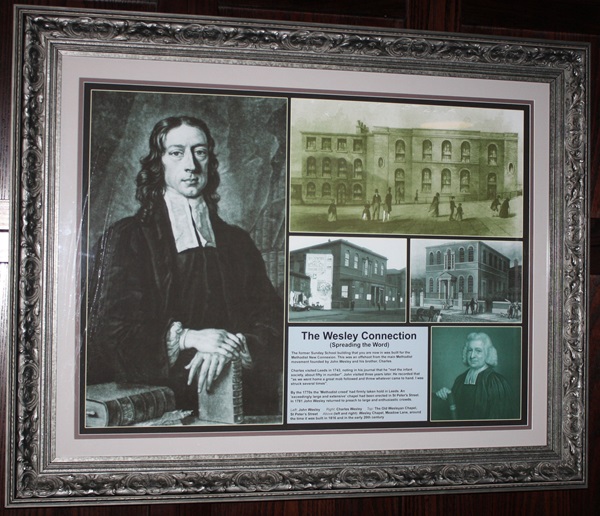
The text reads: The former Sunday School building that you are now in was built for the Methodist New Connexion. This was an offshoot from the main Methodist movement founded by John Wesley and his brother, Charles.
Charles visited Leeds in 1743, noting in his journal that he “met the infant society, about fifty in number”. John visited three years later. He recorded that “as we went home a great mob followed and threw whatever came to hand. I was struck several times”.
By the 1770s the ‘Methodist creed’ had firmly taken hold in Leeds. An ‘exceedingly large and extensive’ chapel had been erected in St Peter’s Street. In 1781 John Wesley returned to preach to large and enthusiastic crowds.
Left: John Wesley Right: Charles Wesley
Top: The old Wesleyan Chapel, St Peter’s Street
Above (left and right): Wesley Chapel, Meadow Lane, around the time it was built in 1816 and in the early 20th century.
Framed photographs of Alan Bennett.
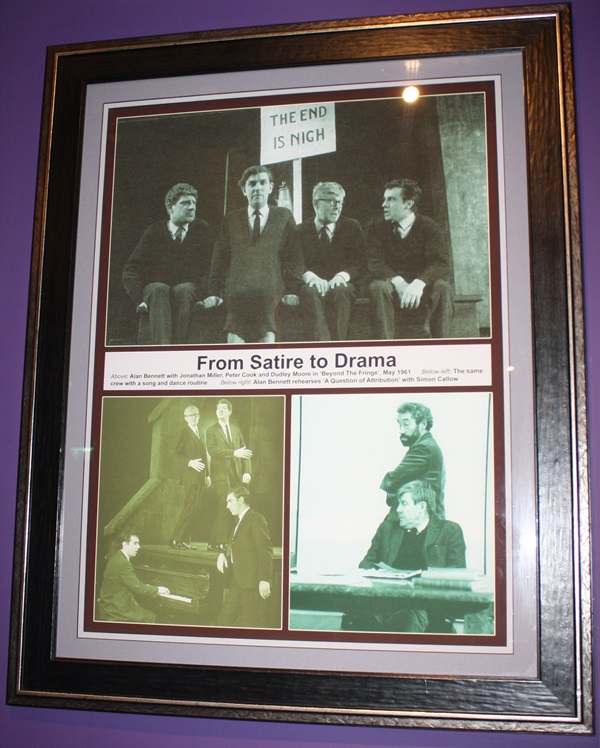
The text reads: Above: Alan Bennett with Jonathan Miller, Peter Cook and Dudley Moore in ‘Beyond The Fringe’, May 1961.
Below left: The same crew with a song and dance routine.
Below right: Alan Bennett rehearses ‘A question of Attribution’ with Simon Callow.
A framed photograph of The Corn Exchange.
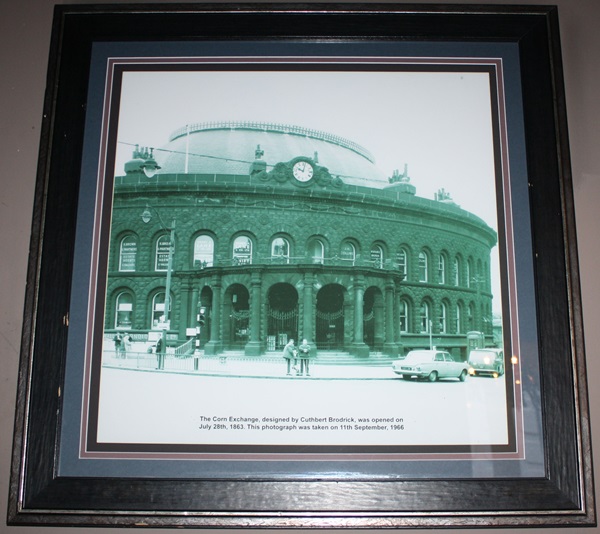
The text reads: The Corn Exchange, designed by Cuthbert Brodrick, was opened on July 28th, 1863. This photograph was taken on the 11th September, 1966.
A framed photograph of The Statue of HR Marsden, in Woodhouse Lane, 1949.
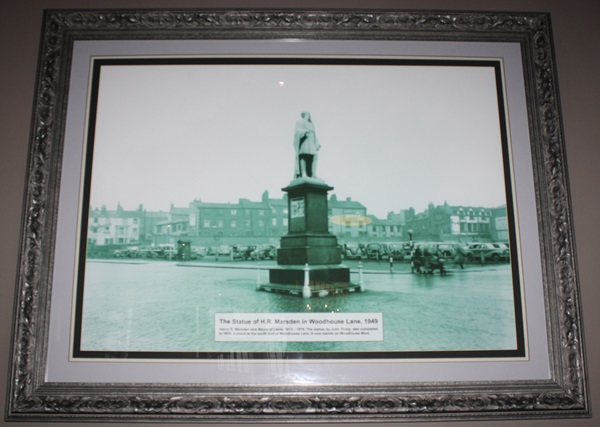
The text reads: Henry R. Marsden was Mayor of Leeds 1873- 1876. The statue, by John Thorp, was completed in 1878. It stood at the south end of Woodhouse Lane. It now stands on Woodhouse Moor.
Framed photographs and text about Arthur Ramsome.
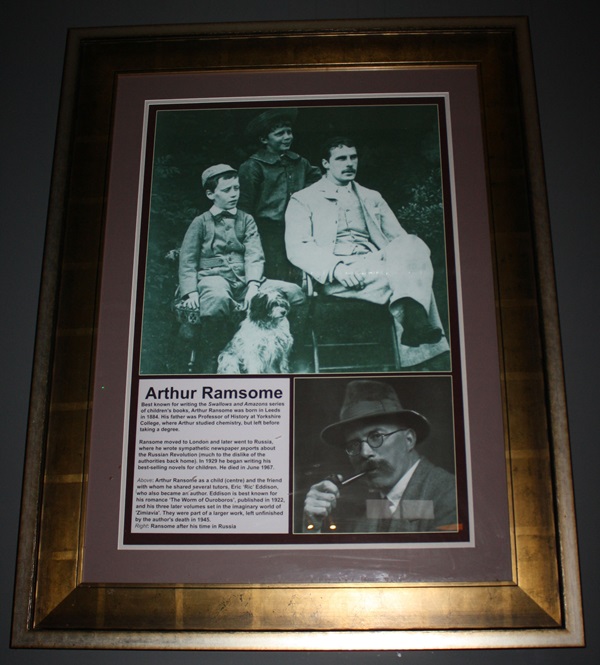
The text reads: Best known for writing the Swallows and Amazons series of children’s books, Arthur Ramsome was born in Leeds in 1884. His father was Professor of History at Yorkshire College, where Arthur studied chemistry, but left before taking a degree.
Ransome moved to London and later went to Russia, where he wrote sympathetic newspapers reports about the Russian Revolution (much to the dislike of the authorities back home). In 1929 he began writing his best- selling novels for children. He died in June 1967.
Above: Arthur Ransome as a child (centre) and the friend with whom he shared several tutors, Eric ‘Ric’ Eddison, who also became an author. Eddison is best known for his romance ‘The Worm of Ouroboros’, published in 1922, and his three later volumes set in the imaginary world of ‘Zimiava’. They were part of a larger work, left unfinished by the author’s death in 1945.
Right: Ransome after his time in Russia.
Framed photographs and text about Alan Bennett.
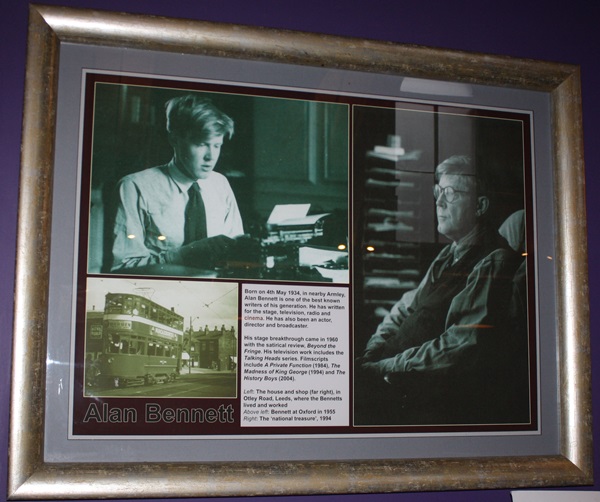
The text reads: Born on 4th May 1934, in nearby Armley, Alan Bennett is one of the best known writers of his generation. He has written for the stage, television, radio and cinema. He has also been an actor, director and broadcaster.
His stage breakthrough came in 1960 with the satirical review, Beyond the Fringe. His television work includes the Talking Heads series. Film scripts include A Private Function (1984), The Madness of King George (1994)
And The History Boys (2004).
Left: The house and shop (far right) in Otley Road, Leeds, where the Bennetts lived and worked.
Above left: Bennett at Oxford in 1955
Right: The ‘national treasure’, 1994.
Framed photographs of The Yorkshire cricket team.
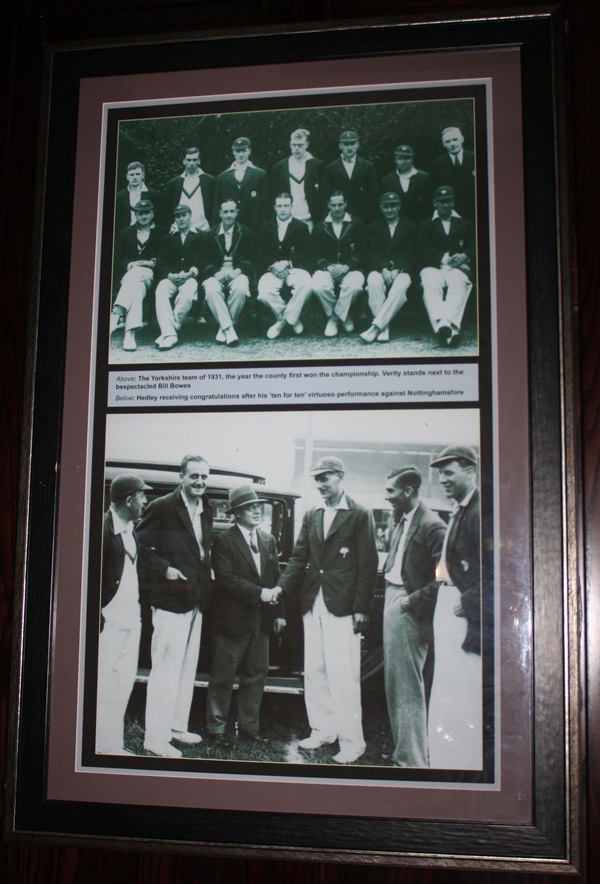
The text reads: Above: The Yorkshire team 1931, the year the county first won the championship, Verity stands next to the bespectacled Bill Bowes.
Below: Hedley receiving congratulations after his ‘ten for ten’ virtuoso performance against Nottinghamshire.
A framed photograph of Yorkshire test match heroes.
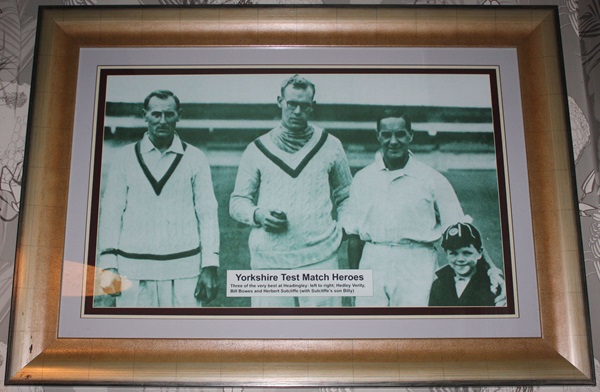
The text reads: Three of the very best at Headingley: left to right; Hedley Verity, Bill Bowes and Herbert Sutcliffe (with Sutcliffe’s son Billy).
A framed photograph of three of Yorkshire’s finest.
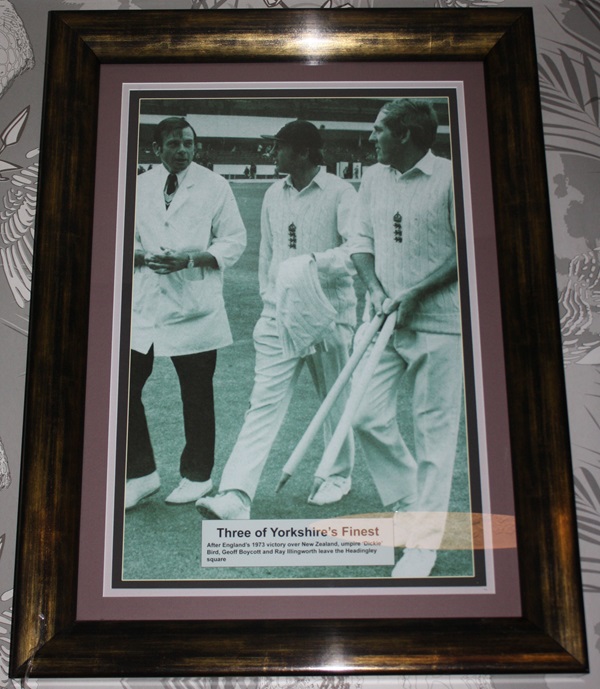
The text reads: After England’s 1973 victory over New Zealand, umpire ‘Dickie’ Bird, Geoff Boycott and Ray Illingworth leave the Headingley square.
A framed photograph of Harold Larwood.
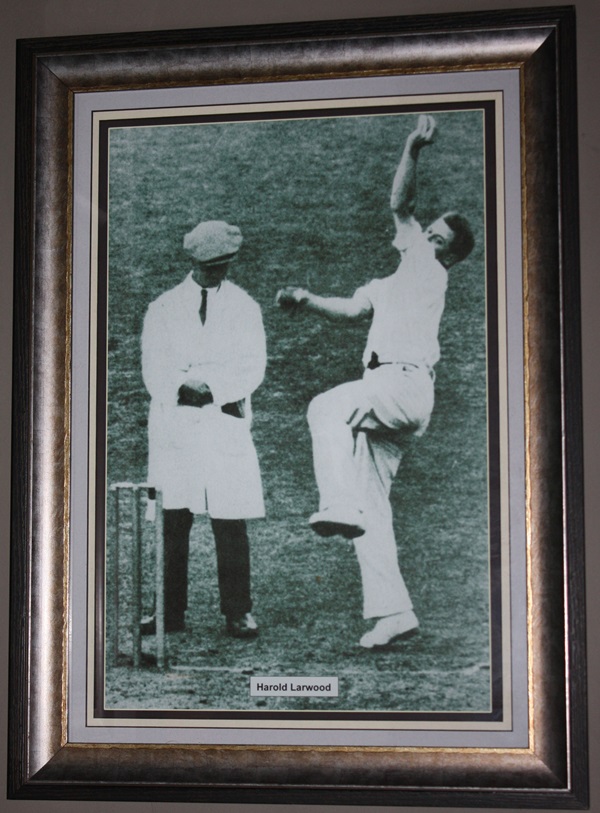
A framed photograph by Bill Bowes of the second ‘Bodyline’ Test – Bradman bowled first ball.
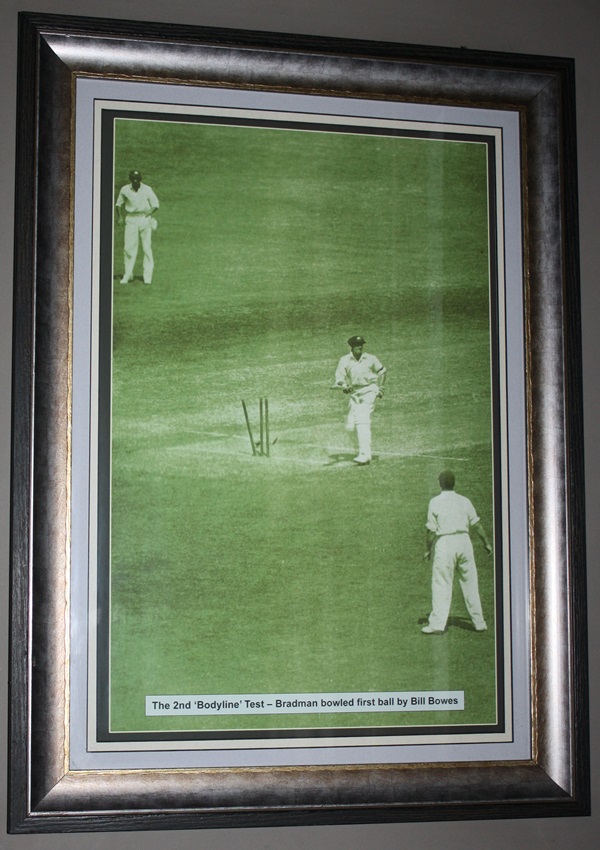
Framed photograph, drawings and text about Yorkshire County Cricket Club.
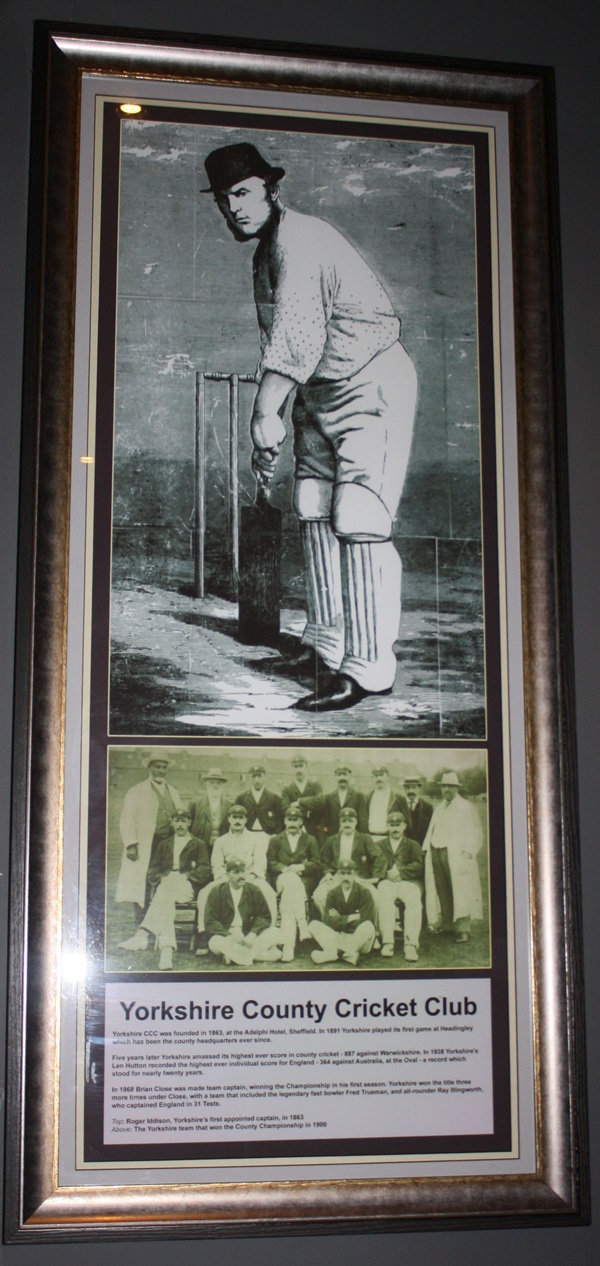
The text reads: Yorkshire CCC was founded in 1863, at the Adelphi Hotel, Sheffield. In 1891 Yorkshire played its first game at Headingley which has been the county headquarters ever since.
Five years later Yorkshire amassed its highest ever score in county cricket – 887 against Warwickshire. In 1938 Yorkshire’s Len Hutton recorded the highest ever individual score for England – 364 against Australia, at the Oval – a record which stood for nearly twenty years.
In 1968 Brian Close was made team captain, winning the Championship in his first season. Yorkshire won the title three more times under Close, with a team that included the legendary fast bowler Fred Trueman, and all-rounder Ray Illingworth, who captained England in 31 Tests.
Top: Roger Iddison, Yorkshire’s first appointed captain, in 1863.
Above: The Yorkshire team that won the County Championship in 1900.
Framed photographs of Yorkshire greats.
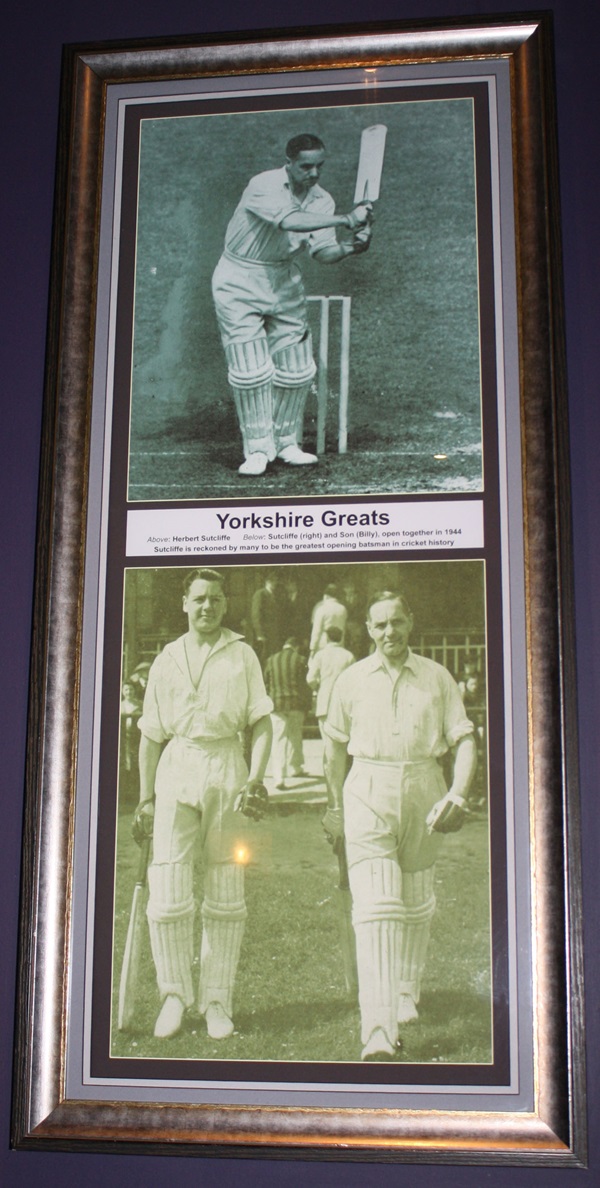
The text reads: Above: Herbert Sutcliffe
Below: Sutcliffe (right) and son (Billy), open together in Sutcliffe is reckoned by many to be the greatest opening batsman in cricket in history.
A framed photograph of one of four lions which guard Leeds town hall.
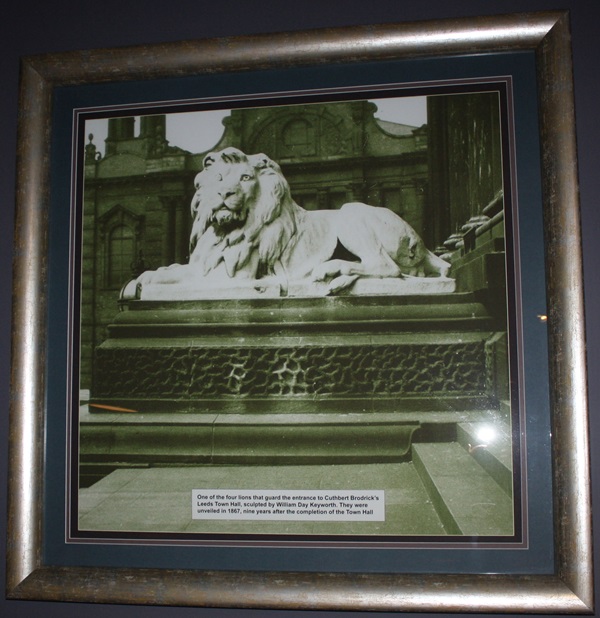
The text reads: One of four lions that guard the entrance to Cuthbert Brodrick’s Leeds Town Hall sculpted by William Day Keyworth. They were unveiled in 1867, nice years after the completion of the Town Hall.
A framed photograph of the Leeds City Skyline.
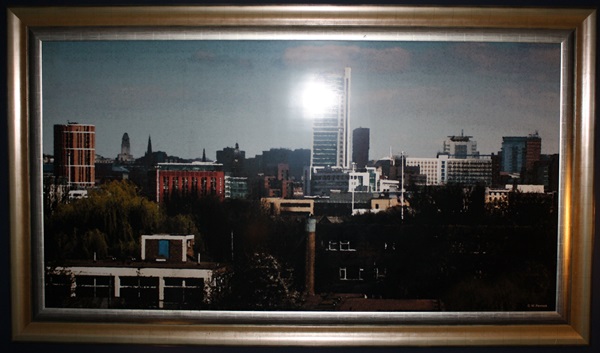
The text reads: Leeds City Skyline, Digital Giclee by artist and photographer C. W. Pennock.
A framed photograph of the central octagon and clock tower of the city markets, built in 1904.
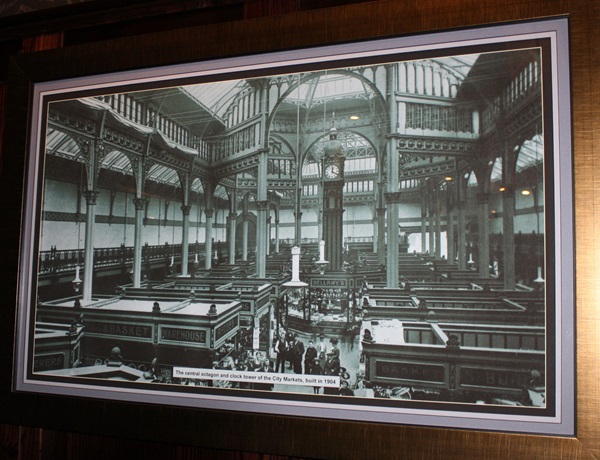
A framed drawing of Leeds Mechanics Institute, c1880.
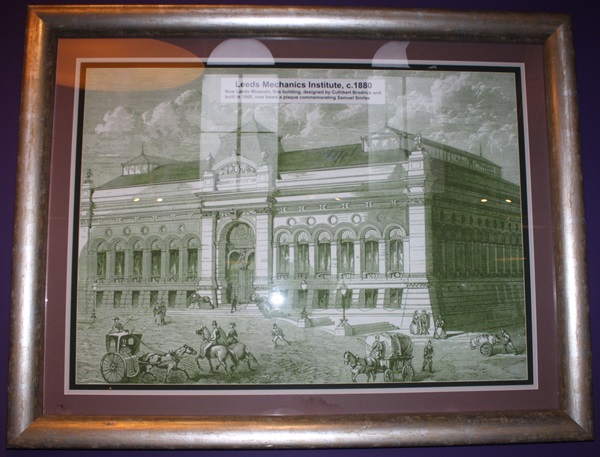
The text reads: Now Leeds Museum, this building, designed by Cuthbert Brodrick and built in 1868, now bears a plaque commemorating Samuel Smiles.
Framed photographs and text about Henry Moore and his work.
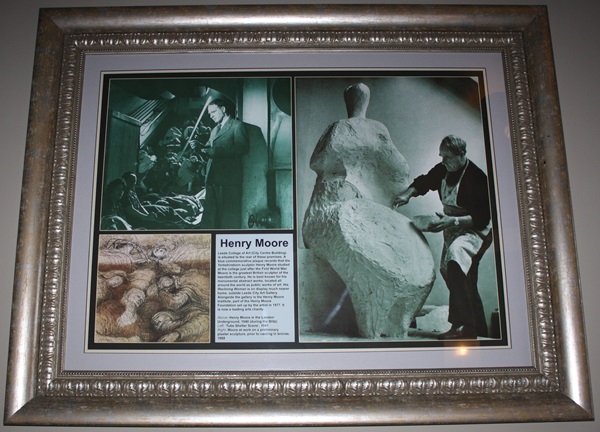
The text reads: Leeds College OF Art (City Centre Building) is situated to the rear of these premises. A blue commemorative plaque records that the Yorkshire born sculptor Henry Moore studied at the college just after the First World War. Moore is the greatest British sculptor of the twentieth century. He is best known for his monumental abstract works, located all around the world as public works of art. His Reclining Woman is on display much nearer home, outside Leeds City Art Gallery. Alongside the gallery is the Henry Moore Institute, part of the Henry Moore Foundation set up by the artist in 1977. It is now leading arts charity.
Above: Henry Moore in the London Underground, 1940 (during the Blitz)
Left: ‘Tube Shelter Scene’, 1941
Right: Moore at work on a preliminary plaster sculpture, prior to casting in bronze, 1968.
Framed drawings by Henry Moore.
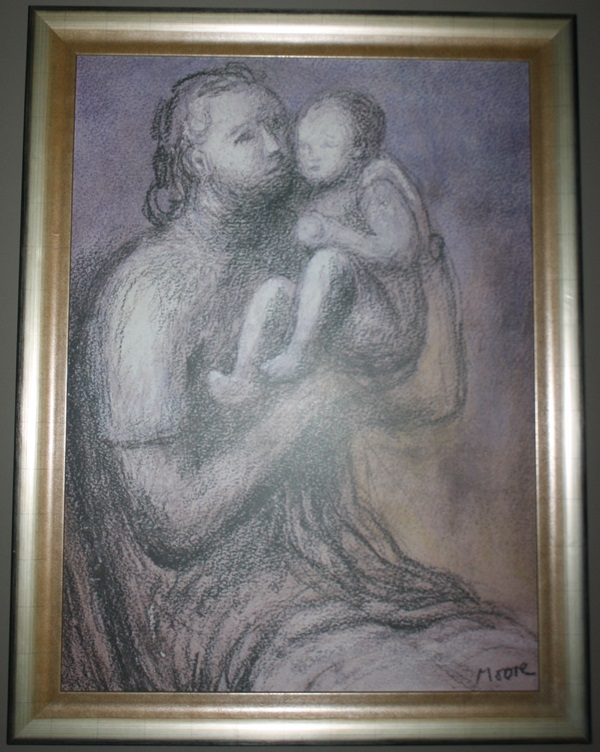
Mother with Child Holding Apple II, 1981
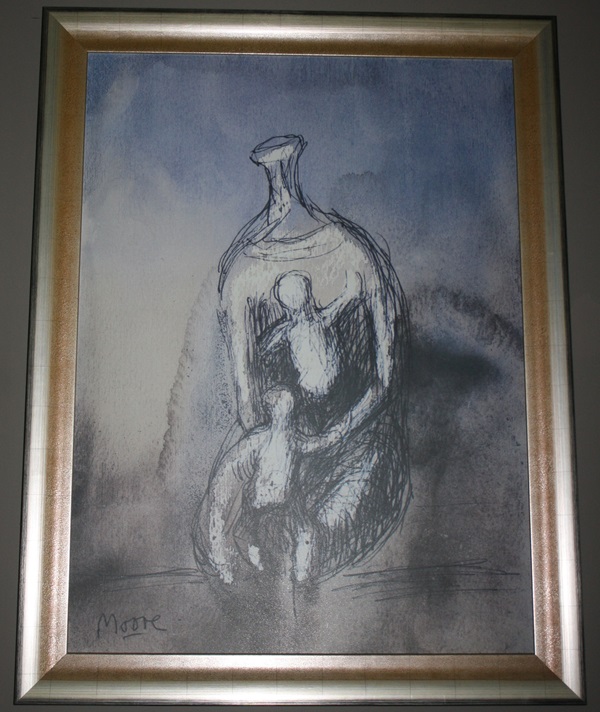
Mother and Twins: Idea for a Sculpture, 1982
An internal photograph of one of the cricket-inspired displays.
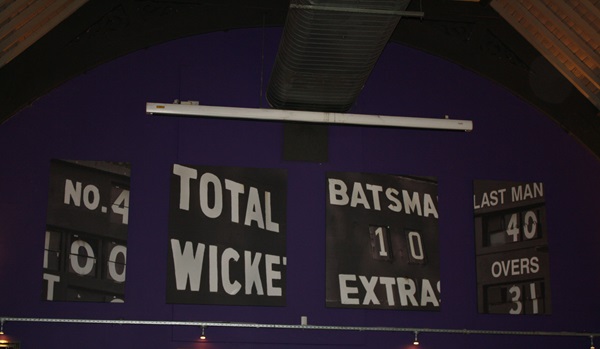
External photograph of the building – main entrance.
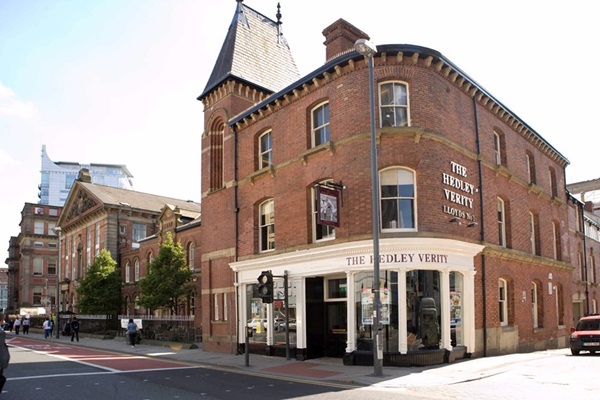
Extract from Wetherspoon News Summer 2019.
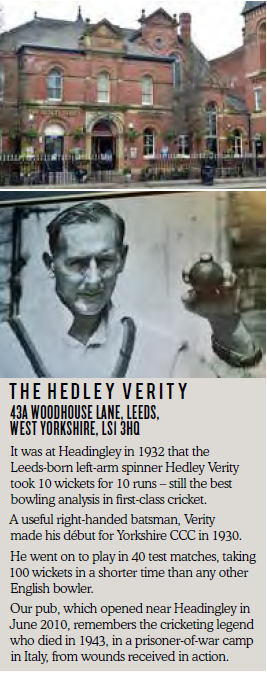
If you have information on the history of this pub, then we’d like you to share it with us. Please e-mail all information to: pubhistories@jdwetherspoon.co.uk